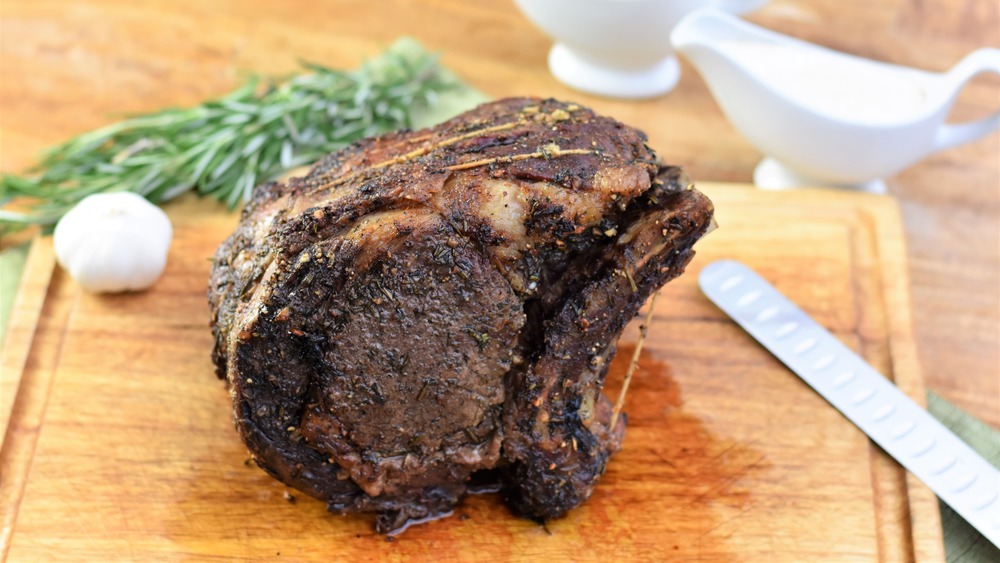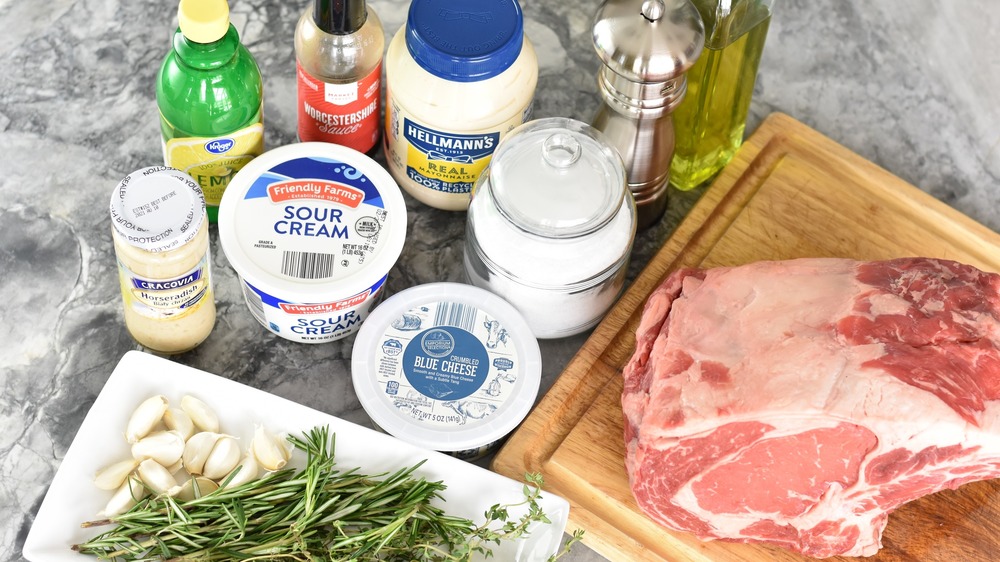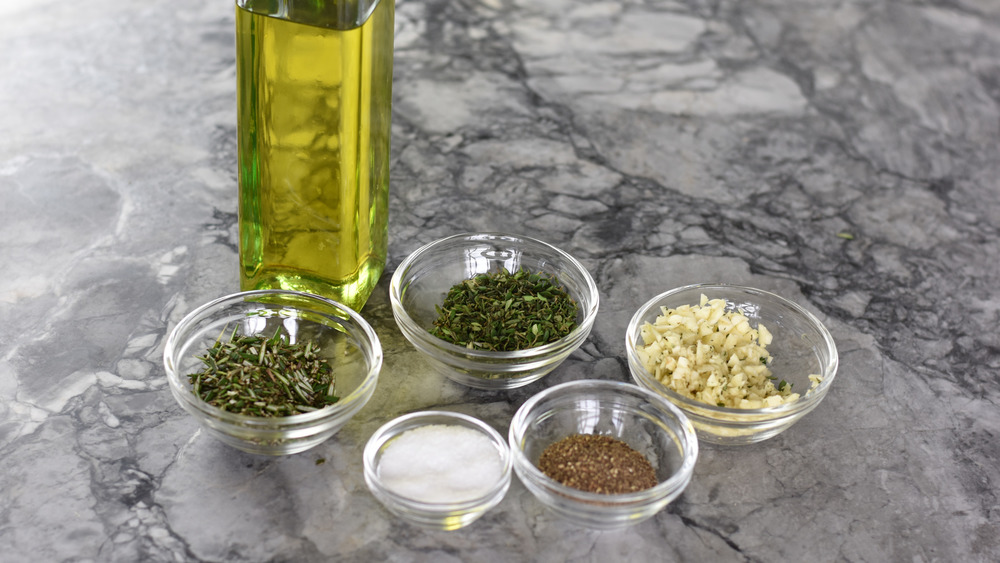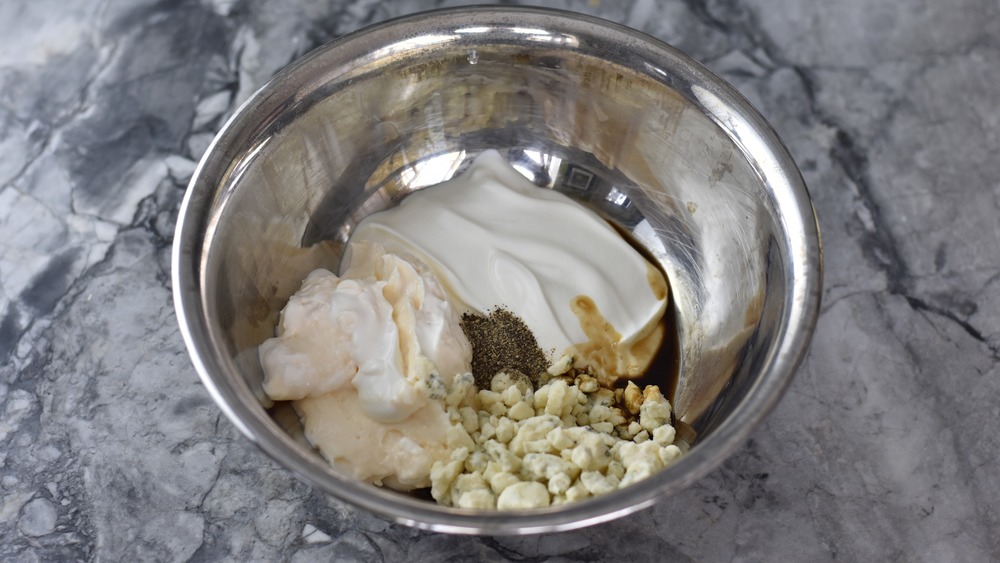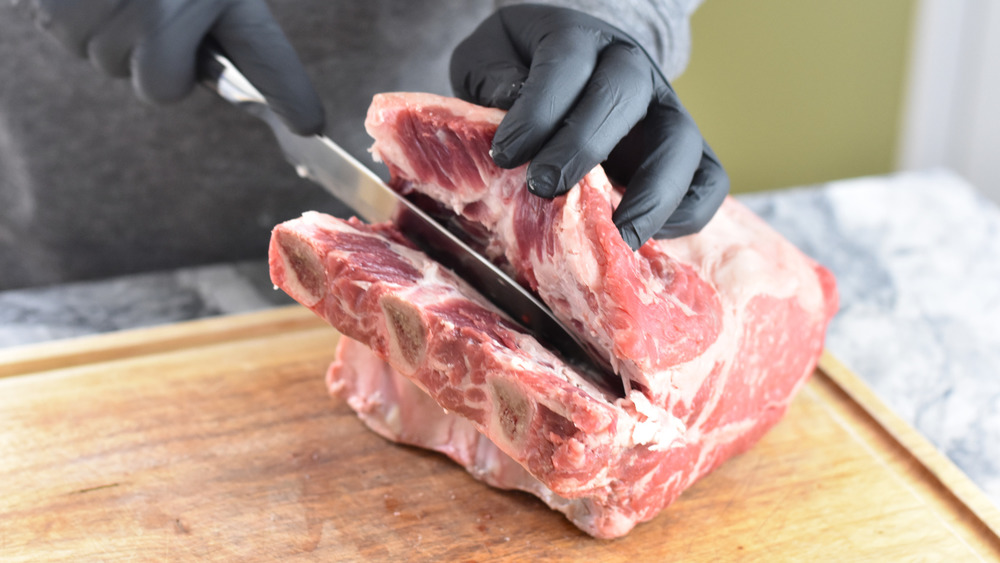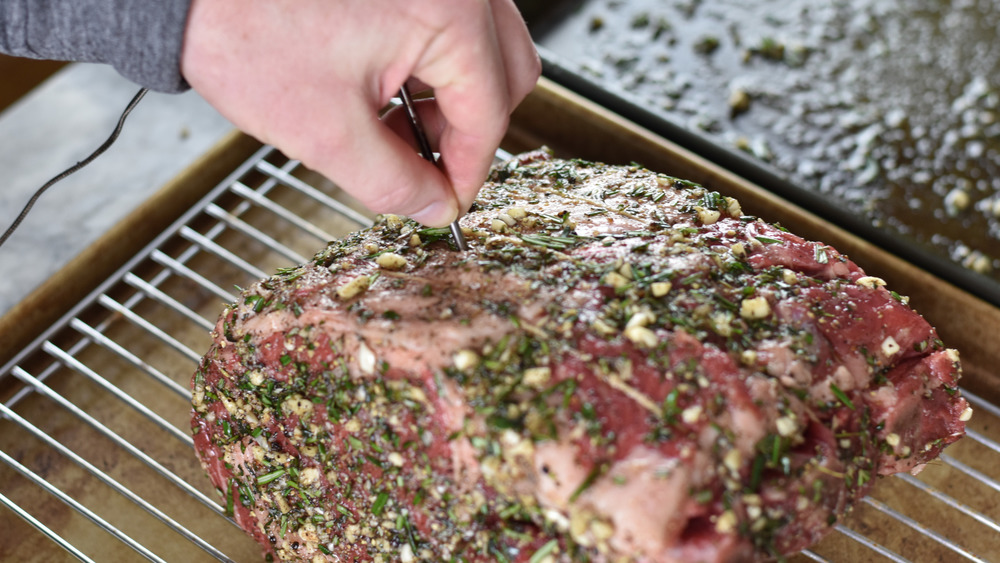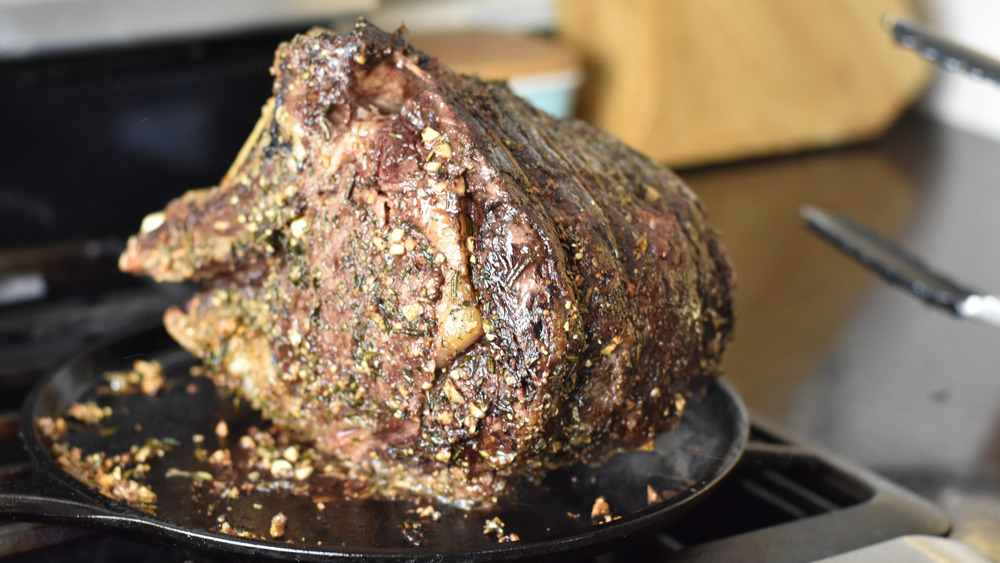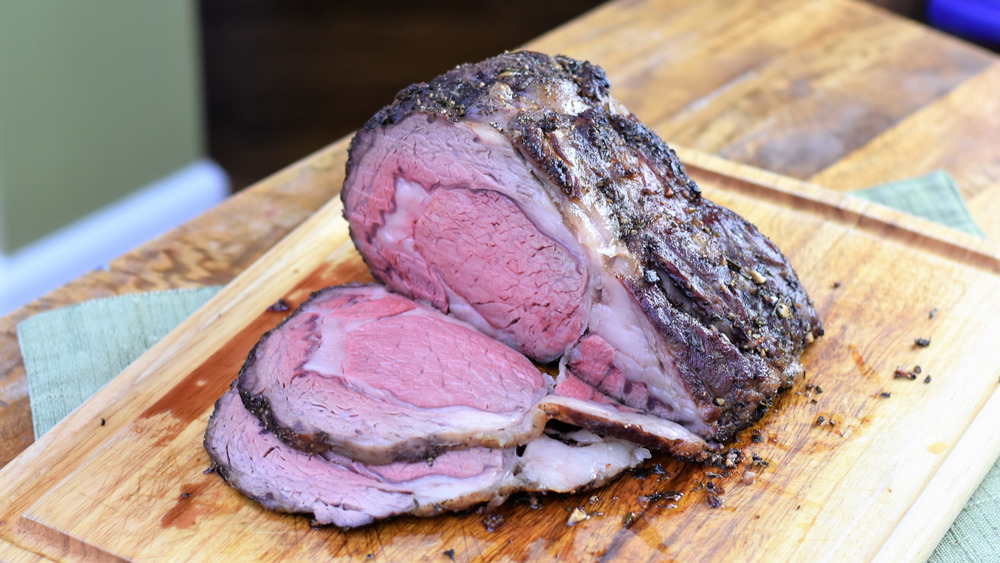Homemade Prime Rib Recipe
Prime rib is one of those high-end meals you'll enjoy once or twice a year for a special occasion or holiday. And if you've dined out at a steakhouse, you know that prime rib comes with a hefty price tag. If you want to indulge in prime rib without the steakhouse markup, you can try Stephanie Rapone's recipe at home for a delicious, more affordable option. Rapone's blog, Pantry to Plate, advises and teaches families how to prepare healthy and delicious home-cooked meals that are fun and fast to prepare.
Her recipe for prime rib is no exception. If you can mix together a few sauces and have decent knife skills, you will be surprised at how easy it is to roast an impressive prime rib in your own kitchen. We're confident that Rapone's prime-rib recipe is so good, you'll never go to a steakhouse again.
Gather together the ingredients for the prime rib
Let's start with the beef. It's commonly known as prime rib, but what you should be asking for at the market or butcher is standing rib roast. "Prime" actually refers to one of the primal cuts butchered from a cow, and although standing rib roast can be USDA Prime beef, most often it is not, according to Cooking for Engineers. A cow has 13 pairs of ribs, which are then cut into smaller portions (via Reference).
Rapone's recipe calls for a five-to-seven pound rib roast with three or four ribs. She recommends calculating 15 minutes per pound for roasting time and an additional 30 minutes for searing and resting the roast. For example, a six-pound roast calculates to 90 minutes of roasting time, plus 30 minutes of searing/resting time, for a total of 120 minutes or two hours. "For this recipe," she told us, "you should start your preparation one-and-a-half to two hours before the roasting time."
The other ingredients for this recipe are for the two sauces that will be served with the prime rib and the herbs and garlic for a pre-roast rub.
Make the garlic and herb rub for prime rib
The rib roast needs to come to room temperature, so take it out of the refrigerator about two hours before you plan on roasting it. During this time, you can get the garlic and herb rub out of the way. Start by stripping the leaves off three large sprigs of rosemary and eight sprigs of thyme. Don't try to cut the leaves off with a knife because you'll likely cut off bits of the stem as well. Simply hold the sprig at the top, and run your fingers back down the stem. The leaves will come right off.
You'll need to mince the herbs fine, particularly the rosemary, which can stay tough even after it's roasted. Mince the garlic, and add it to a bowl with the herbs, kosher salt, and 1/3 cup of olive oil. Mix everything up with a spoon until it forms a coarse paste.
Make the sauces to serve with prime rib
Horseradish sauce is a must for prime rib served at any steakhouse. You'll need some freshly cracked pepper for Rapone's recipe. You'll also need 1/4 teaspoon for the horseradish sauce and the blue cheese sauce too. Pepper is also a must for this dish but, if you don't have a pepper grinder, you can use a kitchen knife to crack the pepper yourself.
To do so, start out with 1/2 teaspoon of whole black peppercorns. Put them on a cutting board or another work surface. Lay the wide part of a chef knife on top. Press down on the knife hard enough to crack the peppercorns. You might need to do this a couple of times to get the peppercorns fully cracked.
Add 1/4 teaspoon of the freshly-cracked black pepper to a small bowl with mayonnaise, sour cream, Worcestershire sauce, lemon juice, and jarred prepared horseradish (not horseradish sauce). Give it a good stir, then taste, and add more horseradish if you like.
Next, for the blue cheese sauce, put the remaining 1/4 teaspoon of cracked pepper in another small bowl. Stir in the mayo, sour cream, Worcestershire, and blue cheese or gorgonzola crumbles, and you're done.
Cut the bones away from the roast and tie it up
Here's your chance for showing off your knife skills. Unwrap the rib roast and blot it dry with paper towels. Using a sharp chef's knife, slide the blade down the bones, peeling back the beef bit by bit. Your goal is to remove all of the rib bones, which should be three or four total.
Alternatively, when you're buying the rib roast, you can ask the supermarket butcher to remove them for you. Either way, remember to save the bones! You'll be tying them back onto the roast before roasting. Why? As Rapone told us: "[Deboning] makes the roast much easier to slice to your desired thickness. But you don't want to ditch the bones because they give great flavor and are delicious to nibble on!"
Once you've cut away the bones, season the cut side with one teaspoon of kosher salt, then lay the bones back on. Cover the bones with the cut meat, so it looks like a whole roast again. Using butcher's twine, tie the roast together in several places. A neat butcher's trick is to twist the twine three times before tying the knot, which will hold the roast firmly in place.
Massage the prime rib with the rub
Now that you've got your roast put back together and tied up, massage the garlic and herb rub into the meat on all sides, pushing the rub into any cracks. Place a baking rack into a baking sheet or a roasting rack into a roasting pan. Lay the roast on top.
Thirty minutes before roasting, preheat the oven to 250 degrees Fahrenheit. If you want to use a probe thermometer, hold it along the side of the roast to see how deep it should go to reach the middle. Insert the thermometer into the top of the roast at the depth you've just measured.
Roast the prime rib, then sear all sides
At the "start roasting time" you've previously calculated, put the roast into the oven, and pour in one-half cup of water. This will prevent the roast drippings from burning in the bottom of the pan. Set the timer for the roasting time — remember, not the total cook time, which also includes the searing and resting time.
Once the timer goes off, check the roast's temperature. It should be between 125-127 degrees Fahrenheit in the middle, which will give you medium-rare in the middle of the sliced roast, and medium to medium-well on the ends for people who prefer more cooked beef.
If the roast hasn't quite reached 125 degrees, leave it in the oven for a few minutes longer. Don't overcook it, though, because the internal temperature of the roast will continue to rise as it rests. When the roast hits the right temperature, take it out of the oven.
To sear, first, heat the vegetable or canola oil in a large skillet over medium-high heat. Sear the roast on all sides for three to four minutes per side. As Rapone reminded us: "There are at least four sides on a roast!"
Let the prime rib rest before carving into slices
Prime rib is a large cut of beef, and like any roast, it needs to rest a while before you carve it. Rapone recommends 20 minutes, which should be long enough for all of the delicious juices exuded during roasting to get absorbed back into the meat. When the resting time is done, cut off the butcher's twine and remove the bones. For those who don't mind gnawing bones like the Flintstones, offer them as an hors d'oeuvre while you slice the prime rib.
Cut the roast against the grain in 1/2 inch or 3/4 inch slices. You may serve by spooning a tablespoon of horseradish and blue cheese sauce over each portion or transfer the sauces to gravy boats for family and guests to serve themselves. "We love this recipe," Rapone told us, "It's a special main dish without being a crazy amount of work or requires a lot of attention." After all, why take out a second mortgage to pay for a steakhouse dinner, when you can cook a steakhouse dinner at home?
Prime rib so good you'll never go to a steakhouse again
If you can mix together a few sauces and have decent knife skills, you will be surprised at how easy it is to roast an impressive prime rib in your own kitchen.
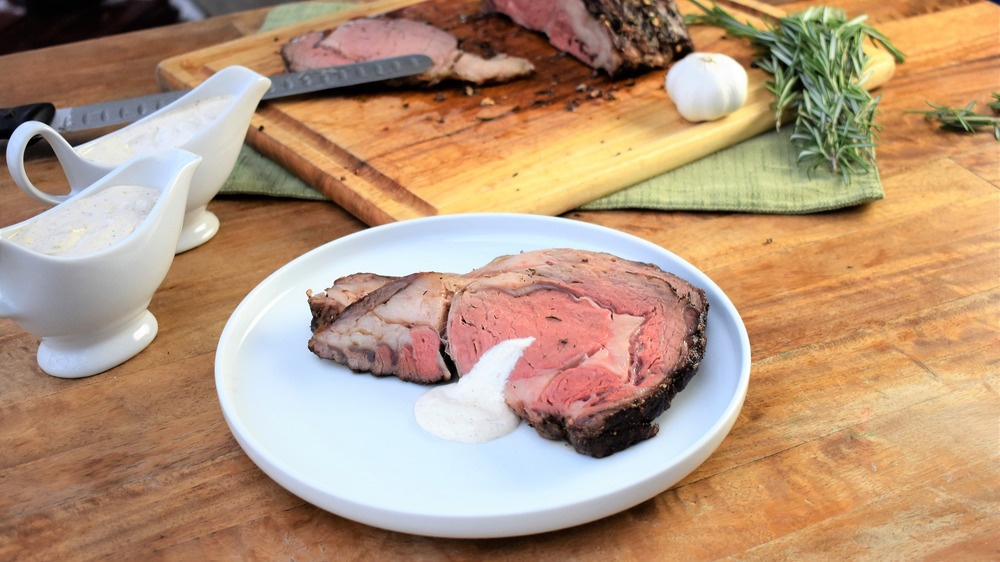
Ingredients
- 7 large garlic cloves
- 1 tablespoon plus 2 teaspoons kosher salt, divided
- 2 teaspoons freshly ground black pepper
- 1/4 cup (about 3 large sprigs) fresh rosemary, finely minced
- 2 tablespoons (about 8 sprigs) fresh thyme, finely minced
- 1/3 cup olive oil
- 1 teaspoon vegetable or canola oil
- 5-7 pound beef rib roast (3-4 ribs)
- 2/3 cup mayonnaise, divided
- 2/3 cup sour cream, divided
- 1 tablespoon plus 1 teaspoon Worcestershire sauce, divided
- 1/2 teaspoon freshly cracked black pepper, divided
- 1 tablespoon jarred prepared horseradish (to taste)
- 1 teaspoon freshly squeezed lemon juice
- 1/4 cup blue cheese or gorgonzola crumbles
- Butcher's twine
Directions
- Calculate the cooking time of your roast at 15 minutes per pound. Also include 30 minutes for resting and searing. If the roast is in the refrigerator, take it out 1 1/2 to 2 hours before preparation, and let it come to room temperature.
- To prepare the rub: Remove the rosemary and thyme leaves from the stems and finely chop. Peel and finely chop the garlic cloves. Combine the herbs, garlic, 1 tablespoon plus 1 teaspoon kosher salt, and 1/3 cup olive oil in a bowl. Combine thoroughly with a spoon until it forms a paste. Set aside.
- For the horseradish sauce: Combine 1/3 cup mayonnaise, 1/3 cup sour cream, 1 teaspoon Worcestershire sauce, 1/4 teaspoon freshly cracked black pepper, horseradish, and lemon juice in a bowl. Mix with a fork until well combined. Taste, and add more horseradish, if desired.
- For the blue cheese sauce: Combine 1/3 cup mayonnaise, 1/3 cup sour cream, 1 tablespoon Worcestershire sauce, 1/4 teaspoon freshly cracked black pepper, and blue cheese (or gorgonzola) crumbles in a bowl. Mix well with a fork, and set aside.
- Unwrap the roast, and blot it dry with paper towels. Carefully cut the bones away from the roast, and save them. Salt the meat side (from where you've just removed the bones) with 1 teaspoon kosher salt.
- Using butcher's twine, tie the bones back onto the meat.
- Rub the garlic and her mixture on all sides of the roast. Place the roast on a roasting rack in a roasting pan. Alternatively, lay a wire baking rack in a sheet pan, and place the roast on top.
- Thirty minutes before roasting, preheat the oven to 250 degrees Fahrenheit. If you have a probe thermometer, hold it against the side of the meat to determine how deep it should be inserted, then insert the thermometer into the top of the roast from that depth.
- Put the roast into the oven, and pour 1/2 cup of water into the pan to prevent drippings from burning. Once the roast has roasted for the time per-pound you calculated, check the temperature. For medium-rare, when the temperature hits 125-127 degrees Fahrenheit, take the roast out of the oven.
- Heat the vegetable or canola oil over medium heat in a skillet large enough to hold the roast. Sear all sides of the roast, 3 to 4 minutes per side.
- Transfer the roast to a carving board and let it rest for 20 minutes. Slice and serve with the horseradish sauce and blue cheese sauce.
Nutrition
| Calories per Serving | 1,103 |
| Total Fat | 99.6 g |
| Saturated Fat | 36.6 g |
| Trans Fat | 0.0 g |
| Cholesterol | 209.7 mg |
| Total Carbohydrates | 3.0 g |
| Dietary Fiber | 0.4 g |
| Total Sugars | 0.9 g |
| Sodium | 752.2 mg |
| Protein | 45.9 g |
